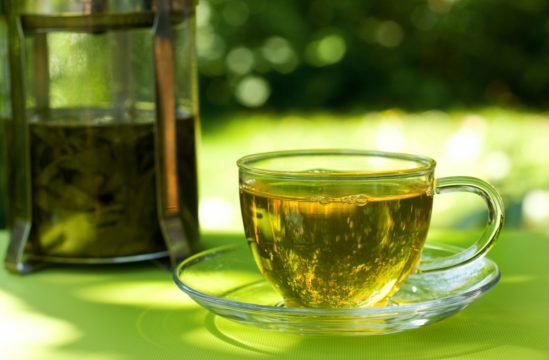Modern medicine is developing rapidly, new methods of treating various diseases, including diabetes, are being constantly developed. Therefore, people completely forget about the recipes of traditional medicine, which can be used as an additional therapy or prevention of the emergence of pathology.

In diabetes mellitus, the activity of the pancreas is disrupted, which causes an increase in the level of glucose in the blood. To normalize the content of this element, you need to take long courses of medication and adhere to dietary nutrition. Not traditional medicine also suggests using various medicinal herbs. One of such plants is the grass cuff in diabetes mellitus.
How useful is this herb?
The cuff is a perennial plant that has small inflorescences. Part of the grass, which is on the ground, has a huge healing power, as it is a rich source of a wide variety of microelements. The plant has an excellent tonic, antiseptic and regenerating effect.
This herb in a short time helps the patient get rid of any cutaneous manifestations, which often occurs in diabetics. If you use it at the initial stage of the disease, you can achieve a positive and lasting effect. The plant allows you to monitor the blood glucose level, without requiring the use of any additional medications.
Recipes, which include a cuff, favorably affect the pancreas, eliminating the increased level of sugar, and also stabilizes the activity of the digestive system. They also help support the body as a whole, strengthen its protective function.
This plant can be always at hand. It can be grown in your garden or on the balcony. To grow it does not require special care, special attention. The cuff is an unpretentious healing herb that can adapt to any conditions, different types of lighting, temperatures. If necessary, it can always be transplanted to new places, it will take root everywhere.
How to use
The cuff for diabetes is used in many ways.
- You can just make a gruel, chopping the grass, previously scalded with boiled water. Then, compress the resulting mass and apply to the affected areas of the skin, leaving for the whole night. This method allows you to cope with the inflammatory processes that occur on the patient's skin.
- Also, the cuff is often applied in the form of infusion, which helps normalize the functioning of the pancreas and digestive system, monitor the blood sugar without taking any special medications.
To prepare recipes, fresh grass can be used, and maybe dried. Collect it must be in the flowering period, and dry in a well-ventilated room.

The most common folk recipes are the following:
- Decoction. To prepare, take 4 tablespoons of the plant and pour a glass of boiled water. Then drain and cool the drink. You need to use it 3 times a day for 150 ml. One course is 2 months, after which you need to pause for 10 days, and then repeat the therapy again.
- Infusion. To prepare this remedy you will need to take 6 teaspoons of the plant, brew a glass of hot water, put on a fire and bring to a boil. After this, it is necessary to remove from heat, leave to stand for several hours. Then you can wet a cotton swab or gauze in this product and apply to the affected areas of the skin.
- Tea. Prepare a cuff and a medical drink. To do this, you need to pour a glass of boiling water one tablespoon of the plant, boil, strain and leave to infuse for 15 minutes. You can drink a drink 4 times a day.
- Salad. Preparation of such a folk remedy implies the following: you need to make a mixture of 150 g of fresh grass leaves and 25 g of green onions. All this is good to grind and mix. Then put another 15 grams of horseradish and mix the mixture with sour cream.
- Decoction of prefabricated herbs. Good to cope with high sugar can a healing drink, which, in addition to the cuff, is also added sage, licorice, dandelion, cowberry, strawberries, lilac buds. All these plants need to be mixed in equal amounts.
Then take 3 tablespoons of the mixture and brew 2 cups of water, put on fire and boil for 5 minutes. After this, drain the beverage and let it brew for 2 hours. Drink the broth should be 50 ml 4 times a day for 15 minutes before meals.
It should be noted that it is recommended to use the cuff for patients who have a second type of diabetes mellitus. In this case, the plant is able to help in the fight against the disease. But if the first type of disease is identified, then it is useless to use herbs, and a full medical course of treatment is required. It must also be remembered that during the therapy the patient must follow the dietary rules, exercise.
Contraindications
The cuff for diabetes is used due to the presence in it of many useful microelements that are able to control the level of sugar in the blood and maintain the state of the body as a whole. Usually, patients perfectly tolerate all the recipes that make up this plant. But there is one exception that does not allow it to be used by some people.
In no case should you use traditional medicine with the addition of a cuff if the patient has problems with blood coagulability. The fact is that this healing herb has the ability to significantly increase coagulability. Therefore, before you begin to be treated with a cuff, you should undergo a laboratory test, the result of which will show whether there are any problems with it.
Undoubtedly, the cuff is an excellent plant that produces a wonderful healing effect. But before you use it, you should consult a doctor. If you need medication, then you should not abandon it in favor of folk remedies.
You can cope with diabetes only if you fully comply with all the recommendations of a specialist. Otherwise, adverse consequences for the life and health of the patient may occur.



